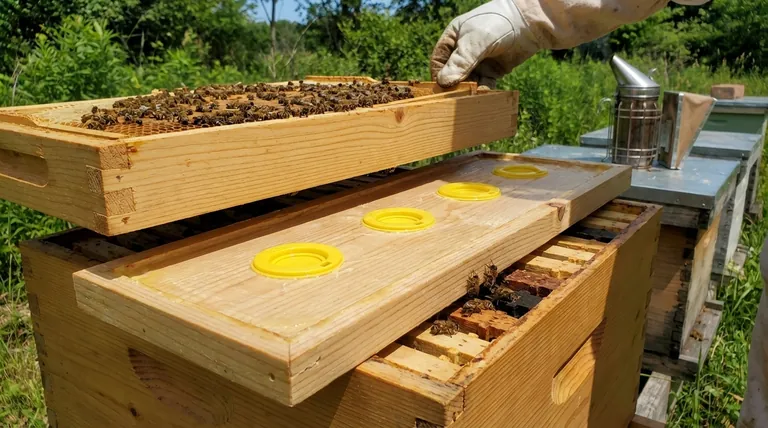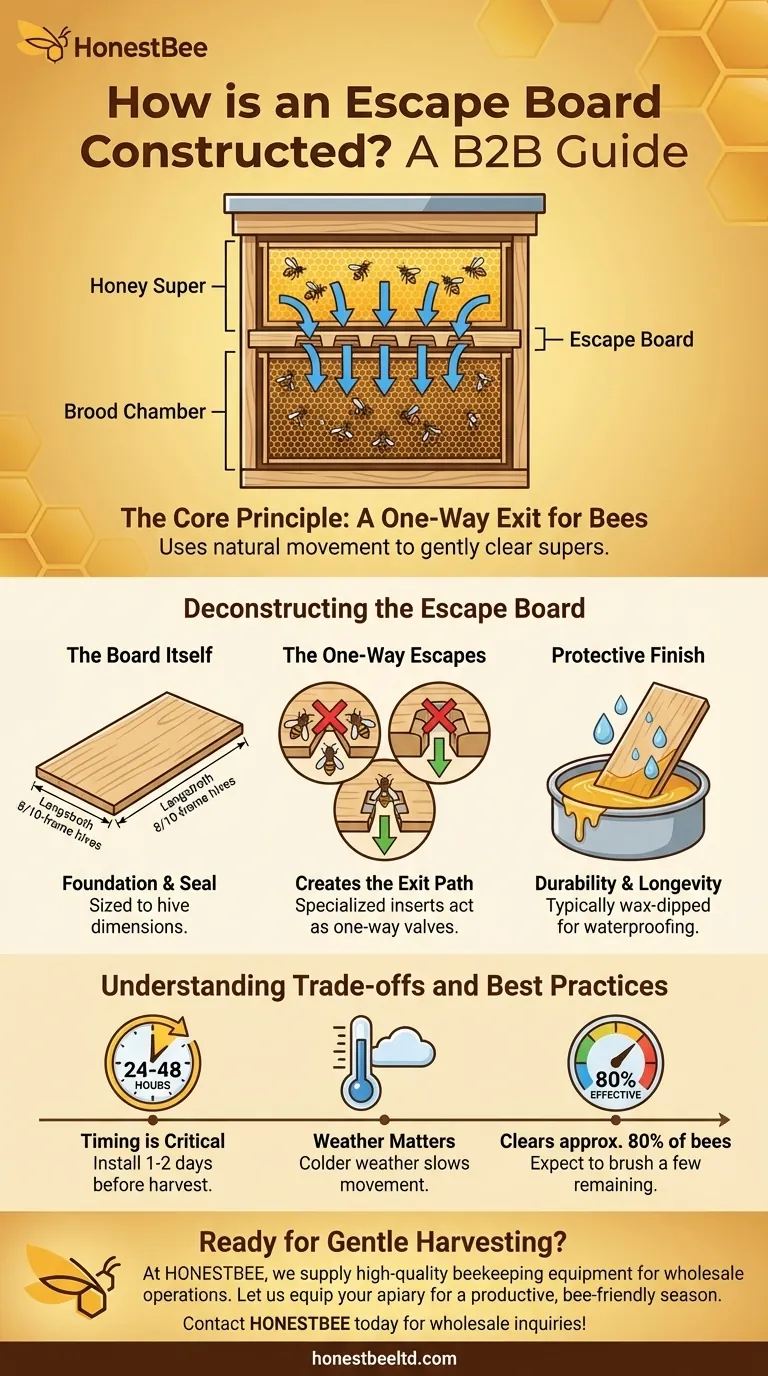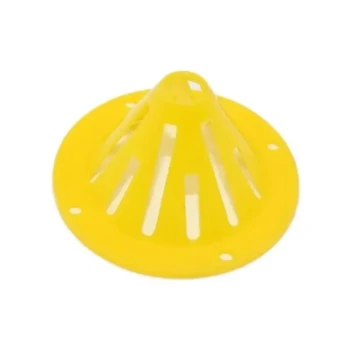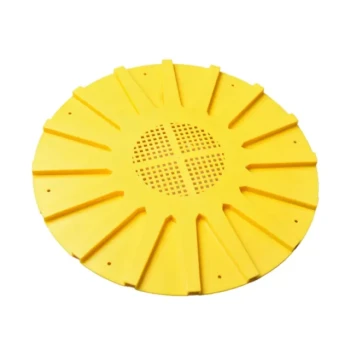In its simplest form, an escape board, also known as a clearer board, is a flat board sized to fit a beehive that contains one or more one-way exits. These exits are designed to let bees move downward out of a honey super but prevent them from traveling back up. The board itself is often dipped in wax to ensure it is durable enough to withstand hive conditions.
The core principle of an escape board is not its physical material but its function: it creates a passive, one-way path that uses the bees' natural movement to gently clear them from honey supers before a harvest.

The Core Principle: A One-Way Exit for Bees
To understand how an escape board is constructed, you must first understand its purpose. It is a tool for quietly and calmly removing bees from a box you intend to harvest.
How Bees Move Through the Board
Bees naturally travel between the upper honey supers and the lower brood chamber. The escape board takes advantage of this movement. When placed underneath a honey super, it allows bees to continue their journey downward into the main hive.
The "Escape" Mechanism
The key components are the "escapes" themselves—small, specialized inserts in the board. These inserts function as one-way valves. Bees can easily push their way through to go down, but the design of the passage makes it nearly impossible for them to find the entrance to return upward. This effectively traps them in the lower sections of the hive.
Deconstructing the Escape Board
While designs vary, nearly all escape boards share a few fundamental components that are critical to their function.
The Board Itself
The foundation is a flat board, typically made of wood, sized to match the dimensions of your hive boxes (e.g., Langstroth 8-frame or 10-frame). It must create a complete seal to ensure bees are forced to use the intended exits.
The One-Way Escapes
These are the most important functional parts. They are inserted into holes cut into the board. The design of the escape creates the one-way passage that is easy for bees to exit but confusing and difficult to re-enter.
Protective Finish
Because the board is exposed to the high humidity and propolis inside a hive, it is typically wax-dipped. This protective coating waterproofs the wood and makes it easier to clean, dramatically increasing its lifespan and preventing it from warping.
Understanding the Trade-offs and Best Practices
Using an escape board is a technique that requires patience and an understanding of its limitations. It is not an instant solution.
Timing is Critical
The board should be installed 24 to 48 hours before you plan to harvest. This gives most of the bees enough time to move down into the brood chamber. Leaving it on for longer than 48 hours is counterproductive, as some clever bees may eventually figure out how to navigate the escape in reverse.
Weather and Temperature Matter
In colder weather, bee movement slows down. It may take the full 48 hours to clear a sufficient number of bees from the super. Plan your harvest timing accordingly.
It's Not 100% Effective
An escape board will not remove every single bee. A successful clearing will remove around 80% of the bees, leaving the honey super light and manageable. You will still need to gently brush off the few remaining bees when you remove the box.
How to Apply This to Your Harvest
Choosing to use an escape board depends on your beekeeping philosophy and goals for harvesting.
- If your primary focus is a calm, chemical-free harvest: The escape board is the ideal tool, as it reduces stress on the colony without using fume boards or chemicals.
- If your primary focus is speed: This method requires planning, as you must wait 1-2 days after installation, making it slower than using a bee brush or blower for immediate results.
Ultimately, the escape board is a simple, elegant tool that leverages bee behavior for a more peaceful harvesting experience.
Summary Table:
| Component | Purpose | Key Details |
|---|---|---|
| The Board | Foundation & Seal | Wood board cut to hive dimensions (e.g., Langstroth 8/10-frame). |
| One-Way Escapes | Creates the Exit Path | Specialized inserts that act as one-way valves for bees. |
| Protective Finish | Durability & Longevity | Typically wax-dipped to waterproof and protect against hive conditions. |
| Effectiveness | Bee Removal Rate | Clears approximately 80% of bees within 24-48 hours. |
Ready to Harness the Power of Gentle Harvesting?
As a beekeeper, you know that the right equipment is key to a successful, low-stress harvest. At HONESTBEE, we specialize in supplying high-quality beekeeping supplies and equipment to commercial apiaries and distributors through our wholesale-focused operations.
We can provide you with the durable components needed to build effective escape boards or other essential harvesting tools. Let us help you equip your operation for a more productive and bee-friendly season.
Contact HONESTBEE today to discuss your wholesale equipment needs!
Visual Guide

Related Products
- Circular Labyrinth Bee Escape for Efficient Hive Management
- Professional Durable Two-Piece Plastic Bee Escape
- Slatted Porter Style Bee Escape for Rapid Hive Clearing
- HONESTBEE Multi Exit Plastic Bee Escape Board for Efficient Honey Harvesting
- HONESTBEE Wooden Bee Escape Board with Triangle Mesh Design for Beekeeping
People Also Ask
- What happens if Triangular Escape Boards are left on for more than 24 hours? Risk of Bee Re-Entry and Failed Harvest
- What is a bee escape and why is it used in beekeeping? A Guide to Gentle Honey Harvesting
- What is the purpose of a bee escape board? A Gentle, Chemical-Free Way to Harvest Honey
- What happens if an escape board is left on for too long? Avoid this common harvesting mistake
- How does a bee escape board work? A Gentle Guide to a Stress-Free Honey Harvest



















